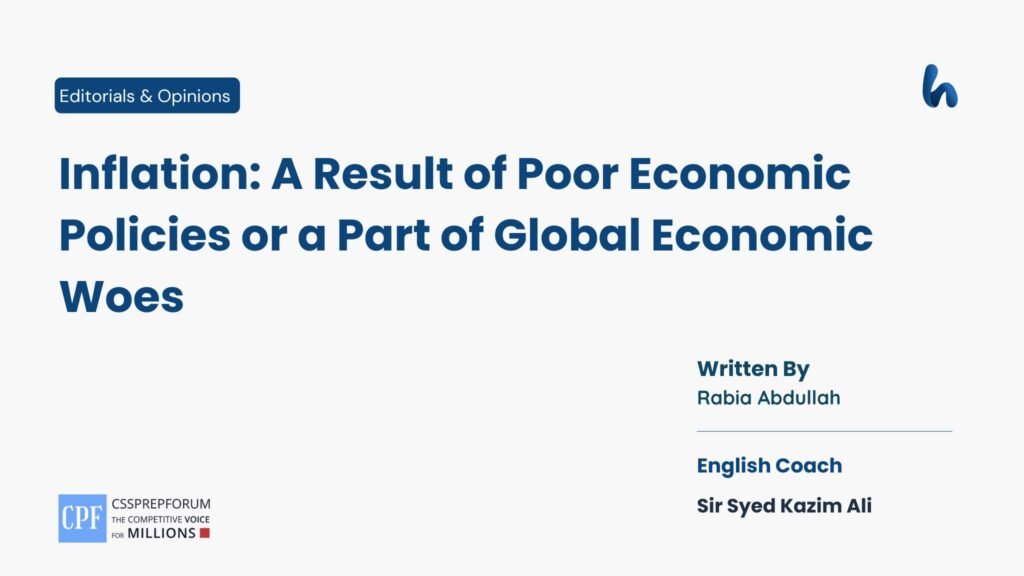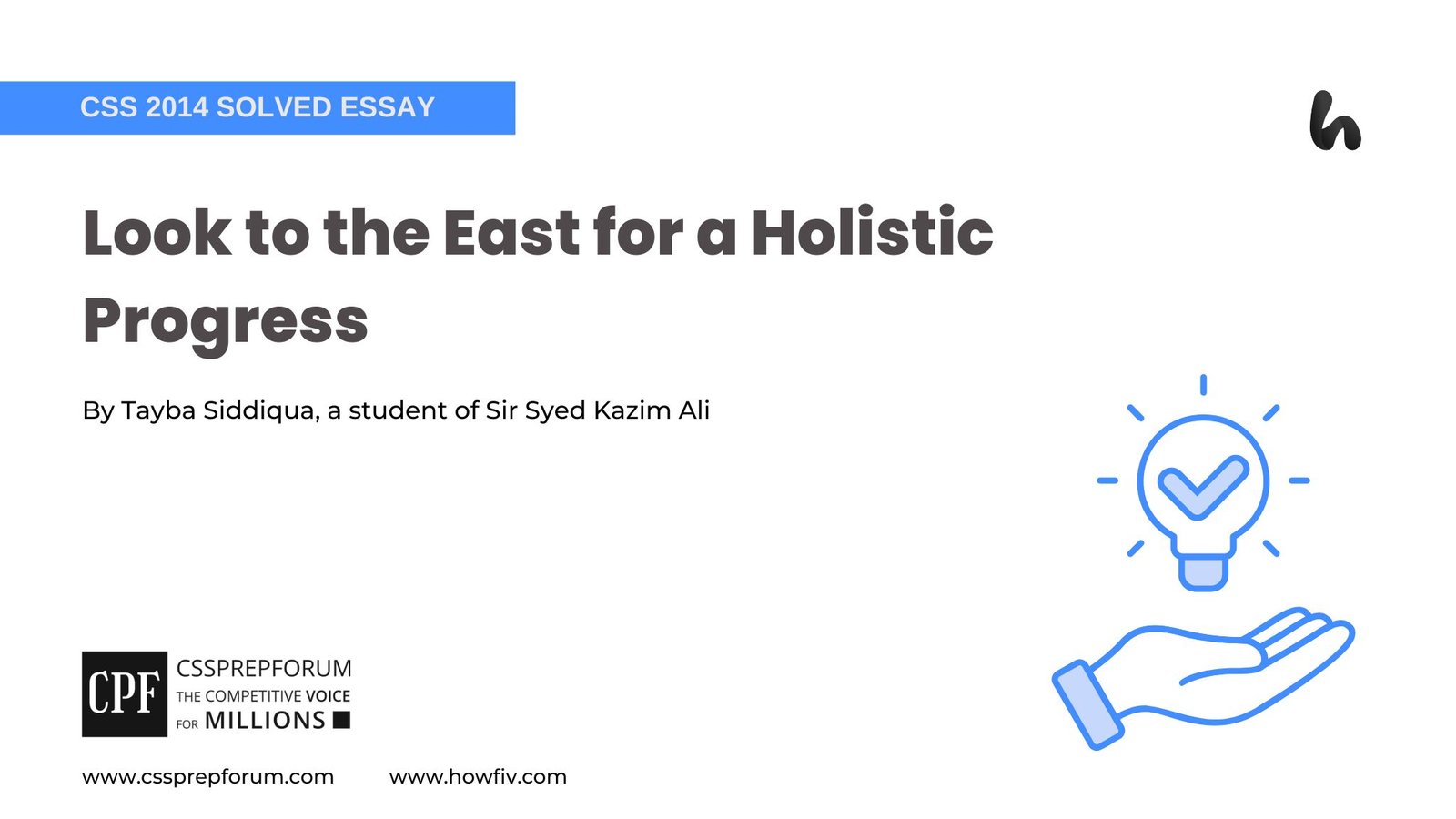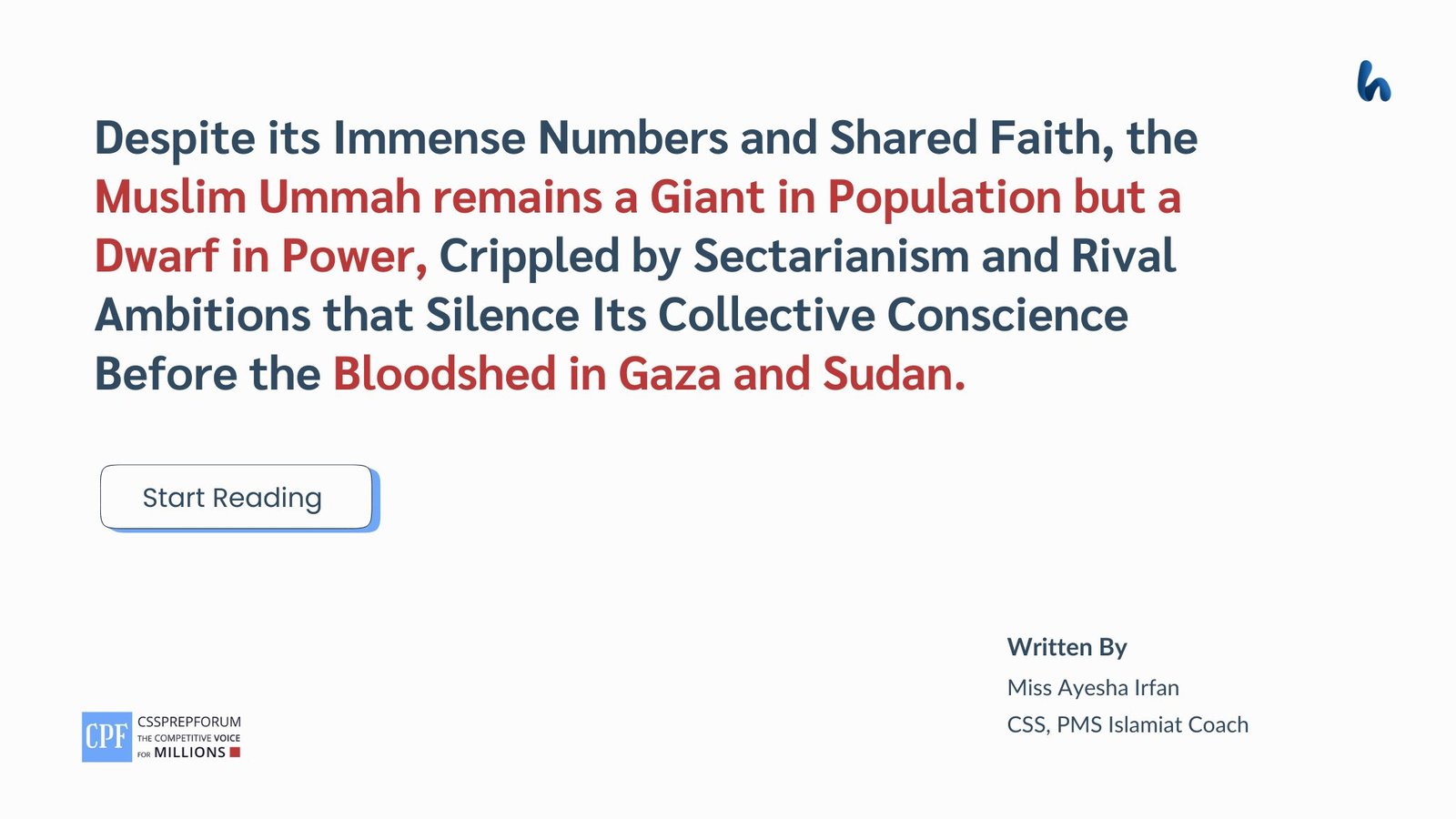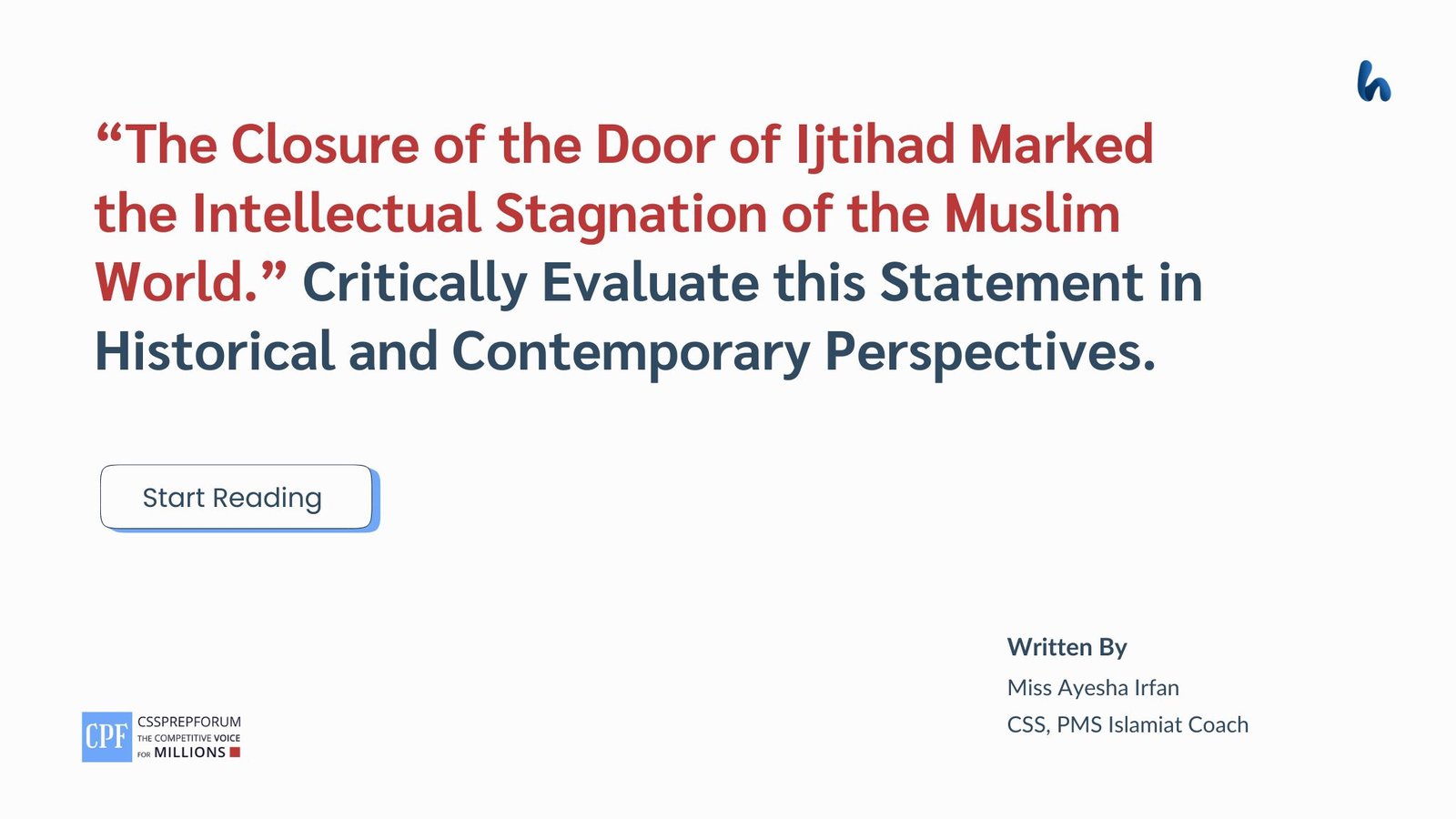Inflation: Poor Economic Policies or Global Economic Woes | Editorials by CSS & PMS Aspirants
The following article, “Inflation: A Result of Poor Economic Policies or a Part of Global Economic Woes”, is written by Rabia Abdullah, a student of Sir Syed Kazim Ali. Moreover, the article is written on the same pattern, taught by Sir to his students, scoring the highest marks in compulsory subjects for years. Sir Kazim has uploaded his students’ solved past paper questions so other thousands of aspirants can understand how to crack a topic or question, how to write relevantly, what coherence is, and how to include and connect ideas, opinions, and suggestions to score the maximum.

Inflation has become an economic nightmare for Pakistan, crippling its purchasing power, stalling investments, and escalating financial instability. While some argue that rising prices are an inevitable consequence of global economic turmoil – spurred by supply chain disruptions, energy crises, and geopolitical instability – others contend that Pakistan’s soaring inflation is primarily the result of its flawed economic policies. Sadly, mismanagement of monetary policy, currency devaluation, an unsustainable fiscal framework, a weak taxation system, and an import-dependent economy have thus left the country vulnerable to economic shocks.

Starting the debate, as Pakistan grapples with rising prices and economic uncertainty, an analysis of whether inflation stems from global financial turmoil or internal economic mismanagement reveals the country’s troubling pattern of poor governance, unrestrained borrowing, and weak institutional oversight that has exacerbated its inflationary pressures.
Monetary Policy Mismanagement
First, monetary policy mismanagement has significantly contributed to inflationary pressures. Notably, excessive borrowing, weak regulatory oversight, and an inflationary money supply expansion have characterized Pakistan’s economic approach. Specifically, the State Bank of Pakistan (SBP) has often succumbed to government pressure, printing money to finance budget deficits instead of controlling inflation through prudent financial regulation. For instance, in 2022-2023, Pakistan’s heavy reliance on central bank borrowing led to a significant increase in money supply, fueling inflation rather than curbing it. As a result, when excessive liquidity is injected into the economy without corresponding growth in productivity, the currency is inevitably devalued, and prices skyrocket. Thus, this cycle of monetary irresponsibility has pushed inflation to record highs, making essentials unaffordable for millions.
Currency Devaluation and the Inflation Spiral
Moreover, currency devaluation has further aggravated Pakistan’s economic crisis. To illustrate, the Pakistani rupee plummeted from 160 PKR/USD in 2021 to over 300 PKR/USD in 2023, mainly due to dwindling foreign exchange reserves and economic uncertainty. Unlike countries that have stabilized their exchange rates through strategic foreign currency interventions and sound economic policies, Pakistan has continuously relied on external borrowing from the IMF and World Bank, weakening its currency. Subsequently, as the rupee loses value, the cost of imports rises – which pushes the prices of fuel, machinery, and essential commodities. Therefore, the government’s failure to shore up foreign reserves and ensure currency stability has directly contributed to inflation, making it one of the country’s biggest economic challenges.
Fiscal Deficits and the Burden of Public Debt
In addition, an unrestrained fiscal deficit has further escalated inflationary pressures. Notably, in FY 2022-23, Pakistan reported a staggering Rs. 6.5 trillion deficit, forcing the government to take on additional loans and increasing the debt servicing cost. Moreover, with public debt spiralling out of control, reliance on indirect taxation and inflationary borrowing has intensified, which further burdens the economy. Instead of implementing long-term reforms to curb unnecessary spending and boost revenue, successive administrations have opted for short-term fixes, borrowing more, printing more money, and imposing ad hoc taxes that disproportionately affect the middle and lower classes. Hence, unchecked fiscal mismanagement has left Pakistan in an endless economic instability cycle.
A Weak Taxation System Enabling Economic Instability
Similarly, Pakistan’s taxation system is riddled with inefficiencies, loopholes, and a low tax-to-GDP ratio. Undoubtedly, only 3 million out of 62 million employed individuals file tax returns, forcing the government to rely heavily on external debt and indirect taxation. Further, instead of broadening the tax net, Pakistan has continued imposing heavy sales taxes, customs duties, and other regressive levies that disproportionately impact the working class. So, the failure to implement a sustainable and progressive tax policy has left Pakistan financially vulnerable, increasing reliance on international lenders while fueling inflation through indirect taxes.
The Pitfalls of an Import-Oriented Economy
Last but not least, an import-dependent economic structure has exacerbated inflationary challenges. To illustrate, in February 2025, Pakistan recorded a trade deficit of PKR 642,635 million, highlighting a perilous reliance on imports for petroleum, machinery, and essential goods. As a result, when global prices fluctuate, disrupting supply chains, the effects are immediately felt in the local economy. Instead of investing in domestic industries and boosting exports, Pakistan continues to rely on imported goods, further exacerbating inflation and economic instability. In contrast, countries like China and Vietnam have successfully controlled inflation by prioritizing industrialization and export-driven growth. Thus, Pakistan’s failure to transition towards a self-sufficient economy has intensified financial volatility.
Global Economic Pressures: An Unavoidable Reality?
Nevertheless, external economic pressures have also played a role in exacerbating Pakistan’s inflation rate. For instance, the Russia-Ukraine war (2022) triggered an energy crisis, causing global oil prices to skyrocket and pushing inflation rates above 10 per cent in many economies, including the United States (US) and Europe. Additionally, the COVID-19 pandemic (2020-2022) severely disrupted global supply chains, which led to food and raw materials shortages and increased prices worldwide. Consequently, these global events contributed to inflation in Pakistan, particularly in sectors reliant on imports. However, despite these external challenges, the devastating floods between June and October 2022 caused significant economic losses estimated at Rs. 3.3 billion, which has not only impacted the country’s agricultural sector but also jolted its sovereignty to the core. Thus, this internal challenge highlights that, besides global economic factors, domestic issues also have played a crucial, central role in shaping Pakistan’s inflationary landscape.
Lessons Learnt from Countries That Controlled Inflation
Before ending the debate, Pakistan should learn lessons from other developing countries that have effectively controlled inflation via policy regulations and management. To illustrate, the US saw inflation peak at 9.1 per cent in 2022 but reduced it to 3 per cent by 2023 through strict monetary controls. Similarly, countries with robust fiscal discipline, such as the UAE and China, prevented excessive inflation despite global crises. Therefore, Pakistan has to implement proactive measures to strengthen its institutions and curtail other internal issues, so the country’s inflation rate can be bridled effectively.
A Crisis of Policy, Not Just Global Turmoil
In conclusion, Pakistan’s inflation crisis is not a byproduct of global economic instability but a direct result of poor economic policies, reckless borrowing, and institutional inefficiencies. Moreover, mismanagement of monetary policy; excessive fiscal deficits; currency devaluation; a weak taxation system; and an overreliance on imports have left the country vulnerable to internal and external shocks. Although global factors – such as energy crises and supply chain disruptions – have played a role, Pakistan’s internal issues have significantly disturbed the country’s inflation graph. Moreover, nations with strong economic management have weathered their internal or external storms far better than Pakistan. Therefore, until the government implements structural reforms to stabilize monetary policy; reduce fiscal deficits; and strengthen domestic industries, inflation would continue to cripple Pakistan’s economy, deepening the country’s poverty rate and economic uncertainty.

CSS Solved Past Papers’ Essays
Looking for the last ten years of CSS and PMS Solved Essays and want to know how Sir Kazim’s students write and score the highest marks in the essays’ papers? Then, click on the CSS Solved Essays to start reading them.
CSS Solved Essays
CSS Solved General Science & Ability Past Papers
Want to read the last ten years’ General Science & Ability Solved Past Papers to learn how to attempt them and to score high? Let’s click on the link below to read them all freely. All past papers have been solved by Miss Iqra Ali & Dr Nishat Baloch, Pakistan’s top CSS GSA coach having the highest score of their students. General Science & Ability Solved Past Papers












